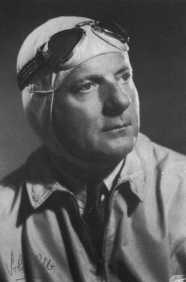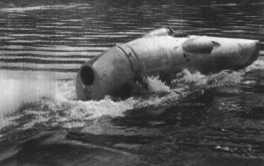

'Crusader's' jet engine was tested many times on the run up to the official attempt, the same engine fitted to the 'Comet' jet airliner, a De Havilland Ghost which produced a 5000 lb static thrust, who's ear shattering whine could be heard reverberating around the Glen. The construction of Cobb's 31 ft long speedboat was of aluminium and marine ply making it a light,dynamic vehicle.
For a number of weeks Cobb gradually pushed Crusader ever closer to the record during test runs and was quietly confident of victory. The world media by this time was beginning to assemble hoping to witness history in the making and the 'Glen's' population was agog with excitement. As each day dawned the anticipation for perfect conditions was overwhelming, this particularly affected the local school children who wanted to be present when the attempt took place. Mr Cobb's press officer, Mr Angus Barr, asked the public to refrain from boating on the Loch during calm weather so 'Crusader' could be tested safely.

On Friday 5th September Cobb held two speed trials, on both occasions the boat handled well. The second trial was faster than the first. 140 mph for the second trial and 20 mph slower on the first. Then 'Crusader' was lifted out of the water for a 48 hr inspection.
Friday 12th September. 'Crusader' back on the loch, did a double run between Drumnadrochit and Invermoriston.
Cobb was confident he had beaten the world record in the run to Invermoriston. The record was held by an American, Mr Stanley Sayres, at 178.4 mph.
By the 16th of September the equipment used by the timekeepers to measure 'Crusader's' speed over the measured mile was in position in the area where the attempt was to be made. By this time patience was wearing thin, time ticked by waiting for the right conditions.
Tuesday 23rd September. Before 8am in the morning 'Crusader' was lowered into the water and Cobb took her for another trial run. Shortly after 8am he shot forward to the run in to the measured mile. A side wind blew her slightly off course. After that false start he was towed back and she streaked off on the measured mile once again reaching over 180 mph. The official timing for that trial was announced later by Lt. Commander Bray of the M.M.A., 185.57 mph for the outward trip and 161.71 mph on the return giving an average of 173.14 mph. An attempt was to be made on Friday the 26th of September for the official record but had to be postponed because it was reported that flood water from the River Garry was bringing driftwood i.e. tree trunks into the loch.
When the morning of the 29th arrived conditions were far from perfect, slight ripples on the surface of the water .By almost 9.30 am conditions had worsened, then events took a turn for the better in that surface conditions had improved dramatically.
 At 11.25 am 'Crusader' was again put in the water at Temple Pier and the official observers boat 'Maureen' set off to land the timekeepers at the Drumnadrochit end of the Loch. The 'Maureen' had reported the timekeeper were ashore at 11.50 am. At 11.55 am 'Crusader's' engine was started and she catapulted out at an angle from Urquhart Bay. Cobb came round to his starting point and revved his engine up to full power. 'Crusader' rose in the water and the attempt was under way, the time was almost 12 noon. With a slight burst of spray in front and a trail of white foam behind she skimmed over the course and reached the second marker. As 'Crusader' reached 200 mph eyewitness accounts say she was hardly touching the water when she came out of the measured mile. Then 'Crusader' started to decelerate to make the second run but hit a wave causing her to bounce twice, she recovered for a second but the next moment the horrified spectators saw the boat plunge in a whirl of spray and foam, flaked with flying wreckage. There was no audible explosion but the boat gave the appearance of bursting apart. Hopes for Cobb's safety was roused when the yellow light attached to his safety apparatus bobbed to the surface. The 'Maureen' made her way to the floating debris and lowered a small boat which reported Cobb had been found. The news brought an immediate call over the radio for a doctor and ambulance, but later it became clear Cobb was dead, probably killed instantly.
At 11.25 am 'Crusader' was again put in the water at Temple Pier and the official observers boat 'Maureen' set off to land the timekeepers at the Drumnadrochit end of the Loch. The 'Maureen' had reported the timekeeper were ashore at 11.50 am. At 11.55 am 'Crusader's' engine was started and she catapulted out at an angle from Urquhart Bay. Cobb came round to his starting point and revved his engine up to full power. 'Crusader' rose in the water and the attempt was under way, the time was almost 12 noon. With a slight burst of spray in front and a trail of white foam behind she skimmed over the course and reached the second marker. As 'Crusader' reached 200 mph eyewitness accounts say she was hardly touching the water when she came out of the measured mile. Then 'Crusader' started to decelerate to make the second run but hit a wave causing her to bounce twice, she recovered for a second but the next moment the horrified spectators saw the boat plunge in a whirl of spray and foam, flaked with flying wreckage. There was no audible explosion but the boat gave the appearance of bursting apart. Hopes for Cobb's safety was roused when the yellow light attached to his safety apparatus bobbed to the surface. The 'Maureen' made her way to the floating debris and lowered a small boat which reported Cobb had been found. The news brought an immediate call over the radio for a doctor and ambulance, but later it became clear Cobb was dead, probably killed instantly.
His body was taken by fast motor boat to Temple Pier where a large silent crowd waited for news. As the report of his death grew from a rumour to a certainty the spectators left and Temple Pier lay deserted. The disaster had been watched by Mrs Cobb from a point above the measured mile. Later she was driven back to Inverness and at 4 pm left by car for London.
Mr Cobb's body was taken to the Royal Northern Infirmary, Inverness where a postmortem examination was carried out.
Wednesday 1st October. Thousands of people lined the streets of Inverness to bid farewell to John Cobb, as the hearse left the Royal Northern Infirmary heading for Surrey.

The timekeeper's log stated that before the disaster Cobb was travelling at 206.89 mph, this is the fastest time ever recorded over water but cannot count as a record as the attempt must be made over two runs in opposite directions.
The record holder, Stanley Sayres fastest speed for a one way run was 185.57 mph.
Cobb's manager said "What John did was to be the first man to travel in water at over 200 mph".
John Cobb's other achievements include, establishing the land speed record at an average of 394.2 mph at Utah, U.S.A., on the 16th September 1947. He was the first man ever to attain a speed of 400 mph on land.
In the same year he was awarded th Seagrave Trophy.
Between 1932-1939 he broke all world records for time and distance up to 24 hrs.
During the Second World War, John Cobb served first in the R.A.F. and then from 1943-1945 as a ferry pilot in the Air Transport Auxiliary.
Story of Cobb Monument...